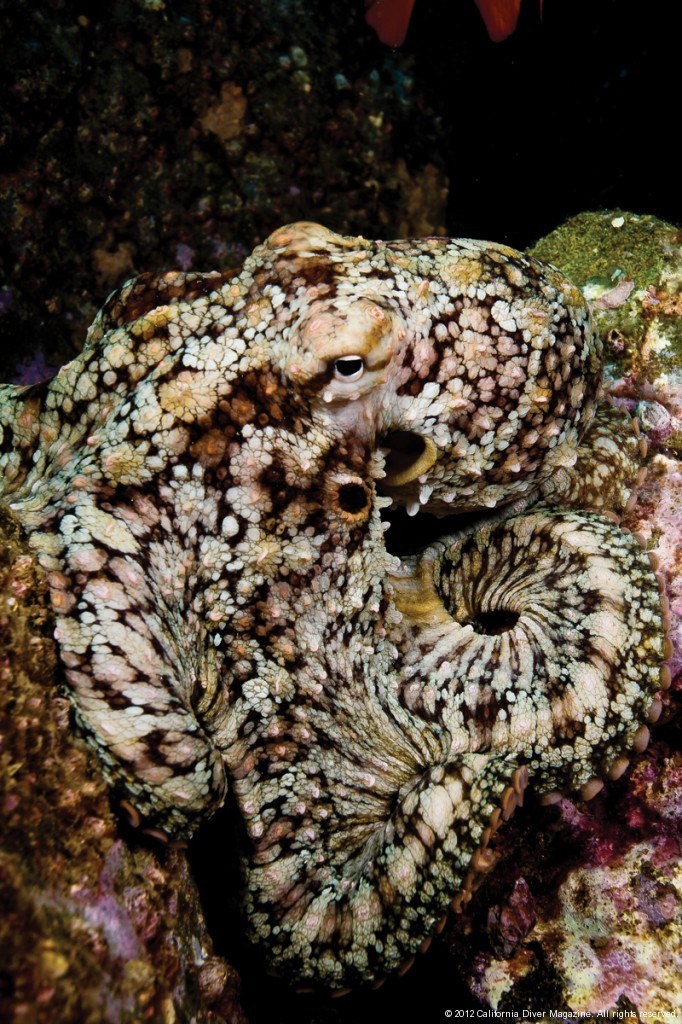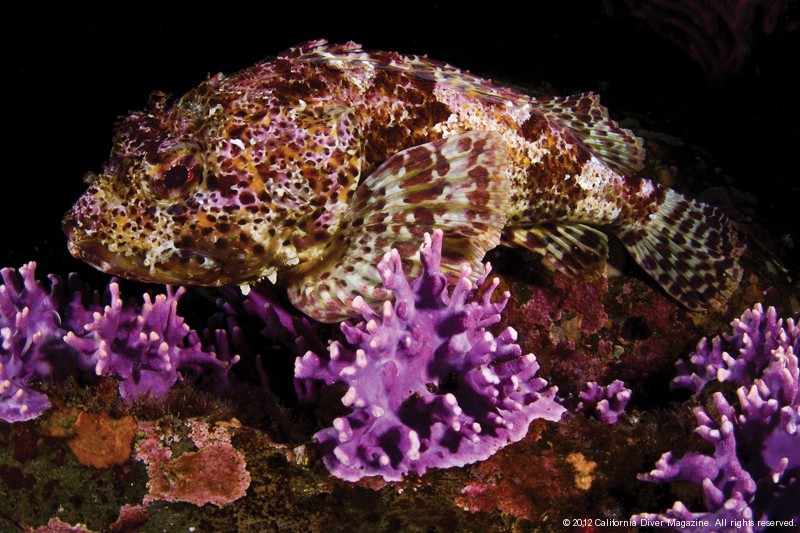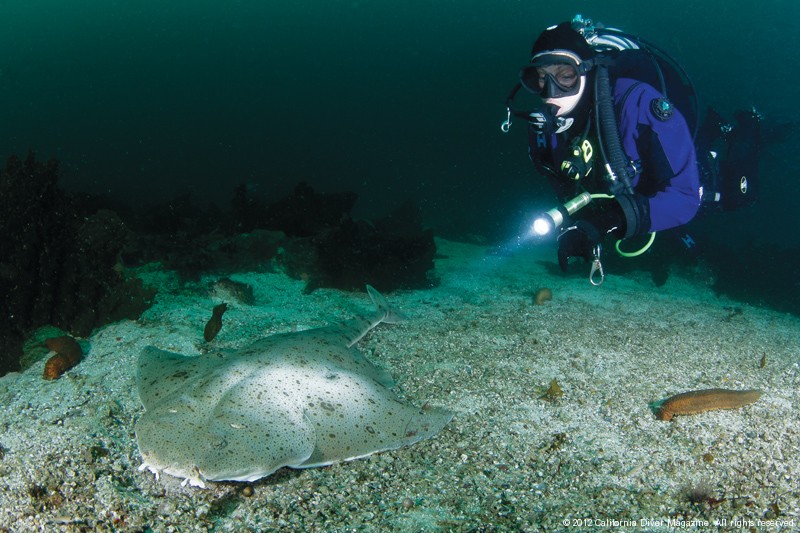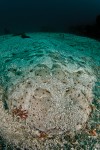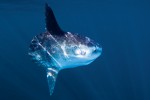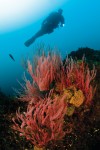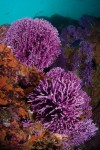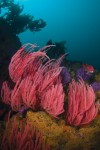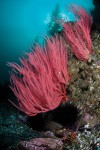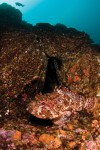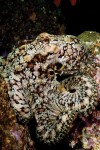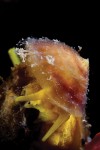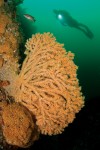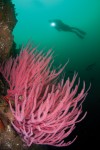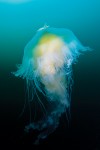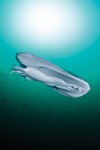Story and photos by Andy Sallmon and Allison Vitsky
Once again, we had been led astray by that stupid swell report. This was a far cry from the 1-2 foot swell that had been predicted. We had enthusiastically woken up at 4 am for this day trip to Farnsworth Banks, but we were no longer feeling very optimistic. Not only was there swell (and at least 5-6 feet of it by our estimation) but it also seemed that there was a pretty short swell period. Farnsworth was not an impossibility, but these were not the surface conditions that we’d dreamed of the night before.
We rounded the West End of Catalina and headed out towards Farnsworth, but as we approached, the captain called the divers together. There were two dive boats already anchored at Farnsworth, and both were reporting less than 15 feet of visibility and ripping currents; combined with the swelly surface conditions, it seemed as if Farnsworth wasn’t going to be an ideal choice for our first dive site. The group dejectedly agreed to head back around to the West End area. The captain, clued into the pouting and overall bad mood, announced, “You know, I think I have a site that might make you all feel better.”
Looks and reluctant snorts were exchanged throughout the galley. Feel better about having to ditch Farnsworth? We doubted it, but we were willing to give it a chance.
MAGIC (AKA “THE SECRET SPOT”)
Sure enough, this place made us feel a lot better. This double pinnacle adjacent to West End was a new site for both of us, and upon our return home, it took a bit of research to find references to it in dive reports. Despite the reports of iffy visibility on Farnsworth, we were gifted with nearly 50 feet of greenish-blue visibility here, and a few jellyfish floated past as we made our descent. The shallower pinnacle topped off at 55 feet and was connected by a narrow strip of rock to a flat-topped adjacent pinnacle that reached 70 feet. Both pinnacles were laden with multicolored gorgonians and zooanthid anemones. Nudibranchs were everywhere we looked, and fish life was also abundant, with rockfish, treefish, and scorpionfish hiding among the rocks, and shy giant kelpfish peeking around the kelp leaves.
We’ve managed to get back to this site only once since our first visit, and it was every bit as amazing the second time around. Our limited experience diving this site hasn’t allowed for a full investigation of the sand and rocks at the pinnacle base, approximately 110 feet, but it appears to be a great place to find rays and angel sharks.
LITTLE FARNSWORTH
The majority of my visits to this site have resulted from failed trips to Farnsworth Banks (its comparatively protected location makes it diveable far more often), but this is never a disappointing consolation dive. This site is close to Avalon, so it’s a common destination for day boats. Little Farnsworth is a double pinnacle very similar in structure to Magic, with the shallower pinnacle reaching a depth of about 55 feet and the adjacent, deeper pinnacle topping off at 70 feet. Large, lush gorgonians, palm kelp, and zooanthid anemones cover the rocky peaks, and when the water has been calm, giant macrocystis kelp can top the pinnacles, as well. A seemingly omnipresent school of mackerel brings in sea lions eager for a snack, and scorpionfish and cabezon are common inhabitants as well. If you’re into the small stuff, you won’t be disappointed: this is one of the best macro sites at Catalina, home to varied gobies, greenlings, snails and crabs, as well as nudibranchs. The pinnacles are surrounded by a deep, sloping sandy bottom that is a great place to spot angel sharks, halibut, and torpedo rays.
FARNSWORTH BANKS
Farnsworth Banks is the Catalina equivalent to El Dorado, for that’s what this site represents to many Southern California divers. In other words, it can take many attempts to actually log a single dive at Farnsworth. Located on the exposed backside of Catalina, a trip to this site requires excellent weather and very calm seas, so planned trips here more often than not wind up rerouted to the calmer front side of the island. Farnsworth is located several miles off of the back side of the island and consists of a series of pinnacles that rise to approximately 60 feet at the shallowest point, then drop off quickly to 70-100 feet. These peaks are surrounded by much deeper water, so they offer more of a chance to see large pelagic creatures than other sites at Catalina. Passing jellyfish are common, and free-swimming torpedo rays are practically a given on any dive here. The major draws here are the prolific purple hydrocoral, huge red gorgonians, and fragile bryozoan colonies which cover the pinnacles. Frequenting the rocks and hydrocoral are numerous cabezon, scorpionfish, and octopus, as well as the occasional lingcod. Macro life here is also dense, with a nudibranch variety that (in our opinion) far surpasses that on the front side of the island.
Considerations for Pinnacle Diving
While the deep waters surrounding Catalina’s pinnacles provide the chance to view pelagic creatures , it also means that divers need to be more cautious. Fishermen also frequent these sites, so fishing line and hooks are often encountered; divers should be equipped with a line cutter or dive knife. These sites are prone to surge and strong and/or changing currents, and divers must plan their dives accordingly. It is critical to remain aware of depth, NDL and air consumption to avoid mishaps. In the sites we describe here, the shallowest structures are at 50 feet or deeper and drop off quickly to depths in excess of 130 feet, so careful navigation is important, and divers should consider remaining within sight of the anchor line when conditions are less than ideal. Pinnacles can be located far from shore, and as a result, boat traffic can be unaware of divers’ presence. As a result, private boats should remember to always fly a dive flag, and divers should ascend on the anchor or drop line unless a free ascent is unavoidable. A large surface marker and calm demeanor is necessary, as even perfect planning and navigation cannot prevent accidents like anchor slippage.
- Angel Shark
- Angel Shark
- California Scorpionfish
- Ocean Sunfish – Mola Mola
- Two-Spot Octopus
Story and photos by Andy Sallmon and Allison Vitsky
©2012 California Diver Magazine. No content may be copied or reproduced without express written permission of the original authors and California Diver Magazine. All rights reserved.

